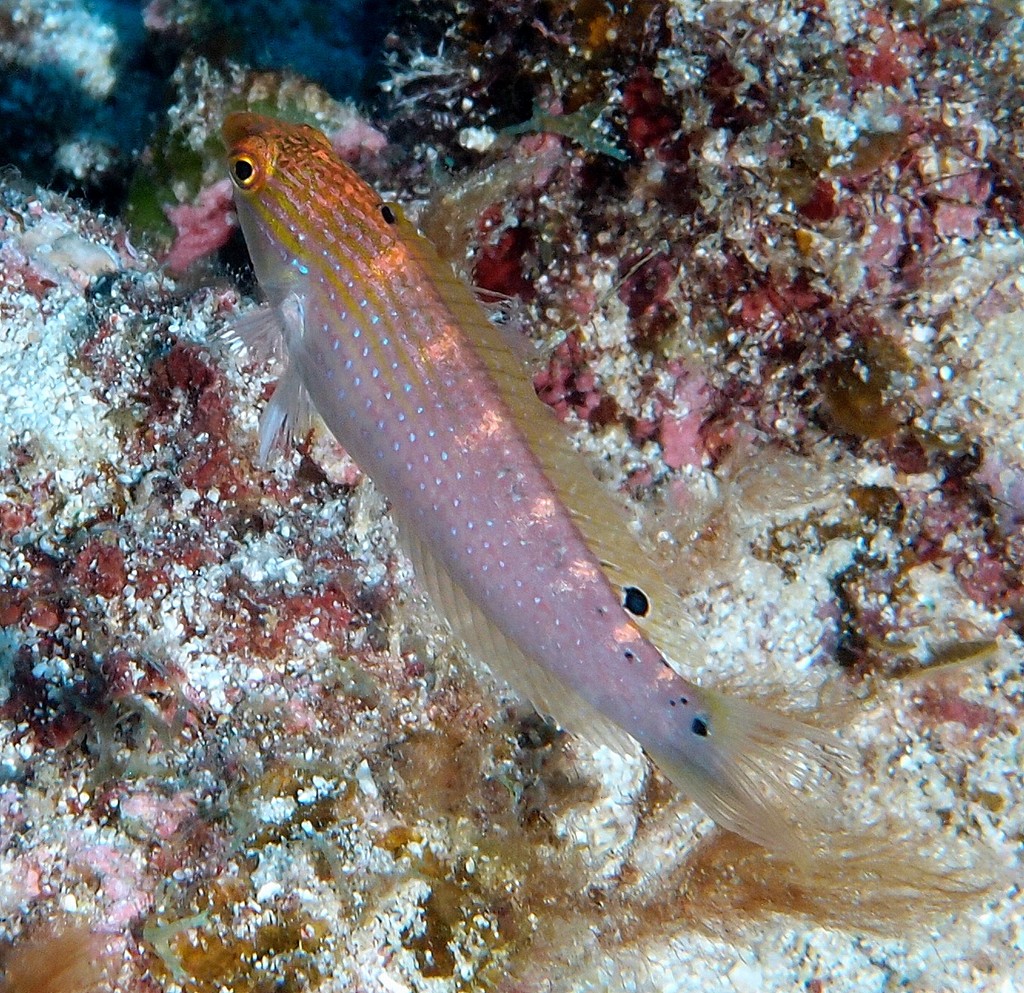SUEZICHTHYS ARQUATUS - (RUSSELL, 1985)
Actinopterygii (Gigaclass) > Actinopteri (Class) > Teleostei (Subclass) > Labriformes (Order) > Labroidei (Suborder) > Labridae (Family) > Suezichthys (Genus)
Painted rainbow wrasse, Rainbow fish, Rainbow slender wrasse, Ade-itobera, アデイトベラ, 青带苏彝士隆头鱼,
Description
Dorsal spines (total): 9; Dorsal soft rays (total): 11; Anal spines: 3; Anal soft rays: 10; Vertebrae: 25. Predorsal scales: 3-5 (rarely: 3-4); Cheek scale rows behind the eye: 2; Cheek scale rows below eye: 3; Scale rows above lateral line: 2½; Low scaly sheath at base of dorsal and anal fins; Lateral line scales with a simple, unbranched laterosensory canal tube. Max. length: 13.5 cm TL. Depth range: 5 - 100 m.
Color
Juveniles and females (initial phase) are reddish above becoming whitish to yellow below, often with faint banding, broken blue lines or rows of spots along the sides, and an ocellus on the upper part of the tail base, and at the front and rear of the dorsal fin.
Males (terminal phase) are olive-green with about five blue lines along the upper side becoming paler yellowish-greenish below with rows of blue spots along the lower side, blue lines on the face and gill cover, a lavender-pink band extending downward from corner of preopercle onto interopercle, reddish dorsal and anal fins with a fine blue margin, and a diagonal yellow line on the upper part of the caudal fin.
Etymology
Suezichthys: from Suez, the Egyptian town + from Greek, ikhthus = fish. In Ichthyological Bulletin No.7, 1957, of this Department, p. 106, the new genus Suezia was proposed, the genotype Labrichthys caudovittatus (Steindachner, 1898) from Suez fish market, As-Suways, Suez Governorate, Gulf of Suez, Red Sea. As Mr Gilbert Percy Whitley (9 June 1903 - 18 July 1975) an British-born Australian ichthyologist and malacologist who was Curator of Fishes at the Australian Museum in Sydney for about 40 years) has kindly pointed out, suezia (Gurney, 1927) was used for a genus in Crustacea, therefore Suezichthys is proposed in replacement.
arquatus: from Latin, arcatus or arquatus = curved into an arch, arcades or vault, made in an arc shape. The term also designates the yellowish color of jaundice (icterus) as well as the orange green color of the rainbow. Referring to its “beautiful, vivid, and many-hued coloration”.
Original description: Suezichthys arquatus Russell, 1985 - Type locality: Nursery Cove (35°28'S, 174°44'E), Poor Knights Islands, New Zealand, depth 13 meters.
Distribution
Western Pacific: New Caledonia, New South Wales (Australia), Norfolk Island, northeast coast of New Zealand, and Kermadec Islands.
Biology
Inhabits sandy patches near algal and sponge covered areas, from estuaries to very deep offshore reefs. Oviparous, distinct pairing during breeding.
Similar species
Suezichthys cyanolaemus (Russell, 1985) - Reported from Southeastern Indian Ocean: Western Australia from Albany to Ningaloo Reef, North West Cape.
Last update: 30, March 2023
Painted rainbow wrasse, Rainbow fish, Rainbow slender wrasse, Ade-itobera, アデイトベラ, 青带苏彝士隆头鱼,
Description
Dorsal spines (total): 9; Dorsal soft rays (total): 11; Anal spines: 3; Anal soft rays: 10; Vertebrae: 25. Predorsal scales: 3-5 (rarely: 3-4); Cheek scale rows behind the eye: 2; Cheek scale rows below eye: 3; Scale rows above lateral line: 2½; Low scaly sheath at base of dorsal and anal fins; Lateral line scales with a simple, unbranched laterosensory canal tube. Max. length: 13.5 cm TL. Depth range: 5 - 100 m.
Color
Juveniles and females (initial phase) are reddish above becoming whitish to yellow below, often with faint banding, broken blue lines or rows of spots along the sides, and an ocellus on the upper part of the tail base, and at the front and rear of the dorsal fin.
Males (terminal phase) are olive-green with about five blue lines along the upper side becoming paler yellowish-greenish below with rows of blue spots along the lower side, blue lines on the face and gill cover, a lavender-pink band extending downward from corner of preopercle onto interopercle, reddish dorsal and anal fins with a fine blue margin, and a diagonal yellow line on the upper part of the caudal fin.
Etymology
Suezichthys: from Suez, the Egyptian town + from Greek, ikhthus = fish. In Ichthyological Bulletin No.7, 1957, of this Department, p. 106, the new genus Suezia was proposed, the genotype Labrichthys caudovittatus (Steindachner, 1898) from Suez fish market, As-Suways, Suez Governorate, Gulf of Suez, Red Sea. As Mr Gilbert Percy Whitley (9 June 1903 - 18 July 1975) an British-born Australian ichthyologist and malacologist who was Curator of Fishes at the Australian Museum in Sydney for about 40 years) has kindly pointed out, suezia (Gurney, 1927) was used for a genus in Crustacea, therefore Suezichthys is proposed in replacement.
arquatus: from Latin, arcatus or arquatus = curved into an arch, arcades or vault, made in an arc shape. The term also designates the yellowish color of jaundice (icterus) as well as the orange green color of the rainbow. Referring to its “beautiful, vivid, and many-hued coloration”.
Original description: Suezichthys arquatus Russell, 1985 - Type locality: Nursery Cove (35°28'S, 174°44'E), Poor Knights Islands, New Zealand, depth 13 meters.
Distribution
Western Pacific: New Caledonia, New South Wales (Australia), Norfolk Island, northeast coast of New Zealand, and Kermadec Islands.
Biology
Inhabits sandy patches near algal and sponge covered areas, from estuaries to very deep offshore reefs. Oviparous, distinct pairing during breeding.
Similar species
Suezichthys cyanolaemus (Russell, 1985) - Reported from Southeastern Indian Ocean: Western Australia from Albany to Ningaloo Reef, North West Cape.
Last update: 30, March 2023
